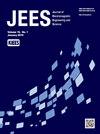Design of Compact and Superdirective Metamaterial-Inspired Two- and Three-Elements Antenna Arrays
IF 1.7
3区 工程技术
Q3 ENGINEERING, ELECTRICAL & ELECTRONIC
Journal of electromagnetic engineering and science
Pub Date : 2023-07-31
DOI:10.26866/jees.2023.4.r.179
引用次数: 0
Abstract
This paper presents the development of a miniature antenna array in a small space in order to achieve superdirectivity for long-range communication. The proposed structures consist of a superdirective metamaterial-inspired array based on a capacitively loaded loop (CLL) driven by an electrically small monopole antenna. This elementary antenna is then used in two- and three-array configurations separated by a fixed interelement distance of 0.1λ to achieve a higher directivity and compact size (with λ the wavelength calculated at the operation frequency 1.850 GHz). The design of the elementary antenna, its simulated radiation performances, as well as those of the parasitic array are also reported. The results of the optimization of two- and three-antenna arrays are discussed. For this study, three corresponding prototypes were fabricated and tested. The measured impedance mismatch and radiation pattern results are presented and shown to be in good agreement with their simulated values. The maximum measured directivity is equal to 5.9 dBi and 4.75 dBi in the case of the two- and three- elements, respectively. The proposed antenna arrays can serve for the realization of point-to-point wireless links and can have a significant impact on compact and high-directive radiofrequency front-ends of a wireless system and for wireless power transfer applications.紧凑超指令超材料启发的二元和三元天线阵列设计
为了实现远程通信的超指向性,本文提出了一种小空间微型天线阵列的研制。所提出的结构包括基于电容负载环路(CLL)的超指令超材料启发阵列,该阵列由电小型单极天线驱动。这种基本天线被用于两阵和三阵配置,元件间的固定距离为0.1λ,以获得更高的指向性和紧凑的尺寸(λ是工作频率1.850 GHz时计算的波长)。介绍了基本天线的设计、模拟辐射性能以及寄生阵列的模拟辐射性能。讨论了双天线阵和三天线阵的优化结果。在本研究中,制作了三个相应的原型并进行了测试。给出了测量阻抗失配和辐射方向图的结果,并证明其与模拟值符合得很好。测量到的最大指向性在二元和三元的情况下分别为5.9 dBi和4.75 dBi。所提出的天线阵列可用于实现点对点无线链路,并且可对无线系统的紧凑和高指向性射频前端以及无线电力传输应用产生重大影响。
本文章由计算机程序翻译,如有差异,请以英文原文为准。
求助全文
约1分钟内获得全文
求助全文
来源期刊

Journal of electromagnetic engineering and science
ENGINEERING, ELECTRICAL & ELECTRONIC-
CiteScore
2.90
自引率
17.40%
发文量
82
审稿时长
10 weeks
期刊介绍:
The Journal of Electromagnetic Engineering and Science (JEES) is an official English-language journal of the Korean Institute of Electromagnetic and Science (KIEES). This journal was launched in 2001 and has been published quarterly since 2003. It is currently registered with the National Research Foundation of Korea and also indexed in Scopus, CrossRef and EBSCO, DOI/Crossref, Google Scholar and Web of Science Core Collection as Emerging Sources Citation Index(ESCI) Journal. The objective of JEES is to publish academic as well as industrial research results and discoveries in electromagnetic engineering and science. The particular scope of the journal includes electromagnetic field theory and its applications: High frequency components, circuits, and systems, Antennas, smart phones, and radars, Electromagnetic wave environments, Relevant industrial developments.
 求助内容:
求助内容: 应助结果提醒方式:
应助结果提醒方式:


